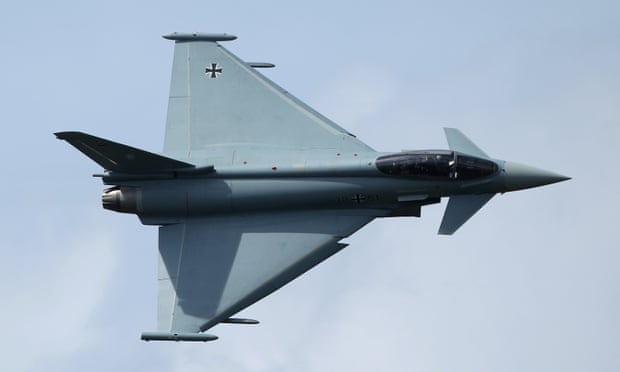The international transfer of weapons to the Middle East has risen dramatically over the past five years, with Saudi Arabia’s imports for 2011-15 increasing by 275% compared with 2006–10, according to an authoritative report.
Overall, imports by states in the Middle East increased by 61%; imports by European states decreased by 41% over the same period. Britain sold more weapons to Saudi Arabia than to any other country. Saudi Arabia is also the biggest US arms market and buys more American arms than British, the report shows.
UK companies are estimated to have sold more than £5.6bn of arms to the Saudis since 2010, and more than 100 new export licences have been approved since the bombing of Yemen began a year ago. British Typhoon strike aircraft sold to Saudi Arabia are embroiled in a growing controversy over the bombing of civilian targets in Yemen.
The figures are contained in the latest arms sales survey by Sipri, the Stockholm International Peace Research Institute.
“A coalition of Arab states is putting mainly US- and European-sourced advanced arms into use in Yemen,” said Pieter Wezeman, senior researcher with Sipri’s arms and military expenditure programme. “Despite low oil prices, large deliveries of arms to the Middle East are scheduled to continue as part of contracts signed in the past five years.”
The report says Saudi Arabia is the world’s second largest weapons importer after India. Elsewhere in the Middle East, arms imports by Qatar rose by 279% over the same period, and imports by the UAE rose by 35%. Egypt’s imports rose by 37%, mainly as a result of a steep rise last year.
Iran’s arms imports are described in the report as at “a very low level” because of arms embargoes. Tehran is now reported to be seeking to buy new weapons following the recent nuclear deal.
Last week Russia’s RIA news agency reported that Russia would sign a contract this year to sell a batch of its Sukhoi Su-30SM multi-role fighters to Iran. The US state department said the sale would violate a continuing UN arms embargo if it occurred without advance security council approval.
Arms imports by Asian countries have also increased significantly, with supplies to Vietnam, mainly from Russia, rising by 699% in five years, according to Sipri. Vietnam has been building up its armed forces in the face of territorial disputes with China in the South China Sea area.
China’s arms exports have increased by 88%, with Pakistan its main weapons market. Russia’s main market is India. The Sipri report says the world’s five biggest arms exporters are the US, Russia, China, France, and Germany.
Original Article
Source: theguardian.com/
Author: Richard Norton-Taylor
Overall, imports by states in the Middle East increased by 61%; imports by European states decreased by 41% over the same period. Britain sold more weapons to Saudi Arabia than to any other country. Saudi Arabia is also the biggest US arms market and buys more American arms than British, the report shows.
UK companies are estimated to have sold more than £5.6bn of arms to the Saudis since 2010, and more than 100 new export licences have been approved since the bombing of Yemen began a year ago. British Typhoon strike aircraft sold to Saudi Arabia are embroiled in a growing controversy over the bombing of civilian targets in Yemen.
The figures are contained in the latest arms sales survey by Sipri, the Stockholm International Peace Research Institute.
“A coalition of Arab states is putting mainly US- and European-sourced advanced arms into use in Yemen,” said Pieter Wezeman, senior researcher with Sipri’s arms and military expenditure programme. “Despite low oil prices, large deliveries of arms to the Middle East are scheduled to continue as part of contracts signed in the past five years.”
The report says Saudi Arabia is the world’s second largest weapons importer after India. Elsewhere in the Middle East, arms imports by Qatar rose by 279% over the same period, and imports by the UAE rose by 35%. Egypt’s imports rose by 37%, mainly as a result of a steep rise last year.
Iran’s arms imports are described in the report as at “a very low level” because of arms embargoes. Tehran is now reported to be seeking to buy new weapons following the recent nuclear deal.
Last week Russia’s RIA news agency reported that Russia would sign a contract this year to sell a batch of its Sukhoi Su-30SM multi-role fighters to Iran. The US state department said the sale would violate a continuing UN arms embargo if it occurred without advance security council approval.
Arms imports by Asian countries have also increased significantly, with supplies to Vietnam, mainly from Russia, rising by 699% in five years, according to Sipri. Vietnam has been building up its armed forces in the face of territorial disputes with China in the South China Sea area.
China’s arms exports have increased by 88%, with Pakistan its main weapons market. Russia’s main market is India. The Sipri report says the world’s five biggest arms exporters are the US, Russia, China, France, and Germany.
Original Article
Source: theguardian.com/
Author: Richard Norton-Taylor

No comments:
Post a Comment